You can Download Samacheer Kalvi 6th Social Science Book Solutions Guide Pdf, Tamilnadu State Board help you to revise the complete Syllabus and score more marks in your examinations.
Tamilnadu Samacheer Kalvi 6th Social Science Geography Solutions Term 1 Chapter 2 Land And Oceans
Samacheer Kalvi 6th Social Science Land And Oceans Textual Evaluation
A. Choose the correct answer
Land And Oceans 6th Standard Question 1.
Which of the following is the smallest ocean on Earth?
(a) The Pacific Ocean
(b) The Indian Ocean
(c) The Atlantic Ocean
(d) The Arctic Ocean
Answer:
(d) The Arctic Oceans
Samacheer Kalvi Guru 6th Social Science Question 2.
The Malacca Strait connects
(a) The Pacific and Atlantic Oceans
(b) The Pacific and Southern Oceans
(c) The Pacific and Indian Oceans
(d) The Pacific and Arctic Oceans
Answer:
(c) The Pacific and Indian Oceans
6th Standard Geography Guide Question 3.
A Which of the following oceans is the busiest ocean?
(a) The Pacific Ocean
(b) The Atlantic Ocean
(c) The Indian Ocean
(d) The Arctic Ocean
Answer:
(b) The Atlantic Ocean
Samacheer Kalvi Guru 6th Social Question 4.
The frozen continent is ……………
(a) North America
(b) Australia
(c)Antarctica
(d) Asia
Answer:
(c) Antarctica
Samacheerkalvi.Guru 6th Social Question 5.
A narrow strip of water that connects two large water bodies
(a) A Strait
(b) An Isthmus
(c) An Island
(d) A Trench
Answer:
(a) A Strait
B. Fill in the blanks :
- The world’s largest continent is ___________.
- ___________ is the mineral rich plateau in India
- The largest ocean is ___________.
- Deltas are ___________ order landforms.
- The Island continent is ___________.
Answer:
- Asia
- Chotanagpur Pkateau
- The Pacific Ocean
- third
- Australia
C. Circle the odd one out
- Africa, Europe, Australia, Sri Lanka.
- The Arctic Ocean, the Mediterranean Sea, the Indian Ocean, the Atlantic Ocean
- Plateau, Valley, Plain, Mountain
- The Bay of Bengal, the Bering Sea, the China Sea, the Tasman Sea.
- The Andes, the Rockies, the Everest, the Himalayas
Answer:
- Sri Lanka
- the Mediterranean Sea
- Valley
- The Bay of Bengal
- the Everest
D. Match the following
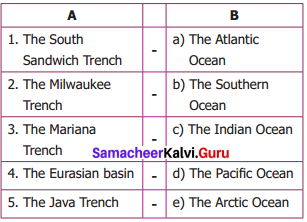
Answer:
- – b
- – a
- – d
- – e
- – c
E.
I. Consider the following statements.
Samacheer Kalvi 6th Social Solutions Question 1.
1. Plains are formed by rivers.
2. The ‘South Sandwich Trench’ is found in the Indian Ocean.
3. Plateaus have steep slopes.
Choose the correct answer using the codes given below.
(a) 1 and 3 (b) 2 and 3
(c) 1,2 and 3 (d) 2 only
Answer:
(a) 1 and 3
II. Consider the following statements.
Samacheer Kalvi 6th Geography Book Question 1.
Statement I : Mountains are second order land forms.
Statement II : The Mariana Trench is the deepest trench in the world.
Which of the statement(s) is/are true?
(a) I is true; II is wrong (b) I is wrong; II is true
(c) Both the statements are true (d) Statements I and II are wrong.
Answer:
(c) Both the statements are true
F. Answer in a word
Samacheer Kalvi 6 Social Science Question 1.
Which is the highest plateau in the world?
Answer:
Tibetan Plateau
Samacheer Kalvi Social Science 6th Question 2.
Name a second-order landform.
Answer:
Mountains, plateaus and plains
Samacheer Kalvi 6th Social Science Book Solutions Question 3.
Which ocean is named after a country?
Answer:
Indian Ocean
Question 4.
Name the islands located in the Arabian Sea.
Answer:
Lakshadweep islands and Minicoy islands
Question 5.
What is the deepest part of the ocean called as?
Answer:
Trench
G. Answer in brief.
Question 1.
What is a continent?
Answer:
The vast landmasses on Earth are called Continents.
Question 2.
Name the continents which surround the Atlantic Ocean.
Answer:
- North America and South America in the west.
- Europe and Africa in the east.
Question 3.
What are oceans?
Answer:
Oceans are vast expanse of water.
Question 4.
List out the names of continents according to their size
Answer:
- Asia
- Africa
- North America
- South America
- Antarctica
- Europe and Australia.
Question 5.
Name the oceans which surround North America and South America.
Answer:
North America : On the west by Pacific ocean, on the east by Atlantic ocean and on the north by Arctic ocean
South America : On the west by Pacific Ocean, on the east by Atlantic ocean.
H. Distinguish between.
Question 1.
A Mountain and a Plateau
Answer:
Mountains
- A landform that rises over 600 metre above its surroundings and has steep slopes is called a mountain.
- Example: Himalayas
Plateaus
- Plateaus are the elevated portions of the Earth that have flat surfaces bounded by steep slopes. The elevation of plateaus may be a few hundred metre or several thousand metre.
- Example: Chotanagpur Plateau
Question 2.
An ocean and a sea?
Answer:
Ocean:
- An ocean is a vast expanse of water.
- Oceans are very deep.
- Example: The Pacific Ocean
Sea:
- A sea is a water body partially or fully enclosed by land.
- Seas are not so deep as oceans
- Example: The Arabian sea
I. Answer the following questions in detail.
Question 1.
Mention the classification of iandforms.
Answer:
First order Iandforms:
(i) Continents and oceans are grouped as first order and forms. the vast land masses on Earth are called Continents and huge water bodies are called Oceans.
(ii) Asia is the largest continent, whereas Australia is the smallest one.
Second order and forms:
The second order and forms are categorised as mountains, plateaus and plains.
Third order and forms:
Third order and forms are formed on mountains, plateaus and plains mainly by erosional and depositional activities of rivers, glaciers, winds and waves. Valleys, beaches and sand dunes are some examples of third order and forms.
Question 2.
Write a note on plateaus
Answer:
- Plateaus are the elevated portions of the Earth that have flat surfaces bounded by steep slopes.
- The elevation of plateaus may be a few hundred metre or several thousand metre.
- Tibetan Plateau is the highest plateau in the world.
- Generally plateaus are rich in minerals.
- Chotanagpur Plateau is one of the mineral rich plateaus in India.
- Deccan Plateau in peninsular India is of volcanic origin.
Question 3.
Plains are highly populated. Give reasons
Answer:
- Plains are a flat and relatively low-lying lands. Plains are usually less than 200 metre above sea level.
- Most plains are formed by rivers, their tributaries and distributaries.
- These plains are used extensively for agriculture due to the availability of water and fertile soil
- They are most suitable for human habitation.
- Hence, they are the highly populated regions of the world.
Question 4.
Give the important features of the Pacific Ocean.
Answer:
- The Pacific Ocean is the largest and deepest ocean on Earth.
- It covers about one-third of the Earth’s total area.
- It is bounded by Asia and Australia in its west and North America and South America in its east.
- On its apex is the Bering Strait. It connects the Pacific Ocean with the Arctic Ocean.
- The deepest point Mariana Trench is located in the Pacific Ocean.
- A chain of volcanoes is located around the Pacific Ocean.
Question 5.
Write down the importance of oceans.
Answer:
- Oceans are the life blood of planet Earth and human kind.
- They flow over nearly three quarters of our planet.
- They hold 97% of the planet’s water.
- They produce more than half of the oxygen in the atmosphere.
- Absorb the most carbon from it.
- The oceans along with the atmosphere, keep temperatures fairly constant world wide.
J. Picture Study.
Question 1.
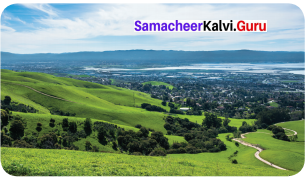
- Name the landform.
- What order of a landform is this?
- By which activity of river is this landform formed?
Answer:
- Valley
- Third Order
- Erosion
K. (ii) ACTIVITY
Question 1.
Give examples for the following using an Atlas.
a. Bay:_______,________,_______
Answer:
Bay of Bengal, Tokyo Bay, Korea Bay
b. Gulf:_______,________,_______
Answer:
Gulf of Kutch, Gulf of Mannar, Gulf of Aden
c. Island:_______,________,_______
Answer:
Sri Lanka, Maldives, Japan
d. Strait:_______,________,_______
Answer:
Strait of Gibraltar, Strait of Magellan, Palk strait
Question 2.
Map reading (with the help of atlas)
a. A sea in the east of India
b. Continents in the westof Atlantic Ocean
c. Continents in the south of Arctic Ocean
d. A strait betweenlndia and Sri Lanka
e. Oceans which surround Australia if.
f. Find out thedsthumusses
(Create more questions)
Answer:
a. Bay of Bengal
b. North America and South America
c. Almost completely surrounded by Eurasia and North America.
d. Palk Strait.
e. Indian Ocean to the west, the South Pacific Ocean to the East and the Southern Ocean to the South.
f. Isthumusses – A Narrow piece of land connecting two larger areas across an expanse of water. Isthumus of Panama – Central America.
Question 3.
On the given outline map of the world, label the continents and mountain ranges.
Answer:
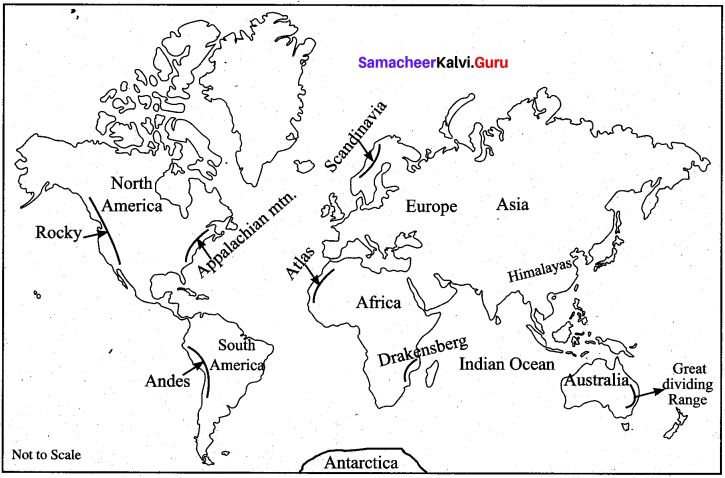
Question 4.
On the given outline map of the world, label oceans, seas, isthumus and straits.
Answer:
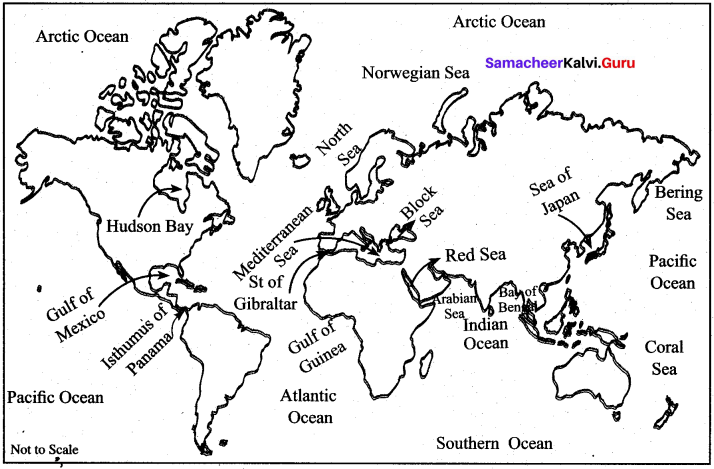
Samacheer Kalvi 6th Social Science Land And Oceans Intext Question
HOTS
Question 1.
December 11 International Mountain Day.
Prepare slogans, posters and placards to celebrate International Mountain Day.
Answer:
- “Mountains are among the most beautiful land masses in the world.”
- “Mountains are beautiful as they rise up above the clouds and show just how grand the world can be.”
- “Great things are done when men and mountains meet. ”
- “How glorious a greeting the Sun gives the mountains.”
- “Mountains are earth’s undecaying monuments.”
- ‘The mountains, forests and seas render men savage, they develop fierce, but yet do not destroy the human.”
- “Men stumble over pebbles, never over mountains.”
- “Each fresh peak ascended teaches something.”
- “Mountains are the beginning and end of all natural scenery.”
- “He who climbs upon the highest mountains laughs at all tragedies, real or imaginary.”
Question 2.
You know the importance of conservation of forests. Do you think conservation of mountains is also equally important?
Answer:
- Mountains make up more than a quarter of the planet’s land mass. These surfaces provide resources for nearly 700 million people through out the world.
- Mountains provide energy resources, food and water to people all around the world.
- But climate change could cause mountains to shrink.
- Deforestation has also been a threat while natural disasters often damage many mountains.
- Mountains are among the most beautiful land masses in the world. So like conservation of forests, conservation of mountains also equally important
Question 3.
When you are walking on the Marina beach in Chennai, which order of landform are you on?
Answer:
Third order of land form.
Question 4.
Why are the Red Sea, Dead Sea and Black Sea named so?
Answer:
(i) Red Sea – It is named Red sea because it contains a Cyanobacteria which turns the normally blue – green water a reddish one. It gets connected to the ocean without even one river meeting the sea.
(ii) Black Sea – The Black Sea was first named by the ancient greeks as in hospitable sea. The sea got this reputation because it was different to navigate and hostile tribes inhabited its shores. After the successful development of the coast by the Greek colonists, the sea was named hospitable sea.
(iii) Dead Sea – The Dead Sea is roughly 8.6 times saltier than the ocean. This salinity makes for a harsh environment in which animals cannot flourish.
Question 5.
When you travel from Japan to California, which ocean would you travel across?
Answer:
Pacific Ocean.
Question 6.
When you arrange the continents in ascending order according to their size, which ranks third?
Answer:
Antarctica.
Samacheer Kalvi 6th Social Science Land And Oceans Intext Activities
Question 1.
Complete the given table with the help of an atlas. Follow the example

Answer:

Question 2.
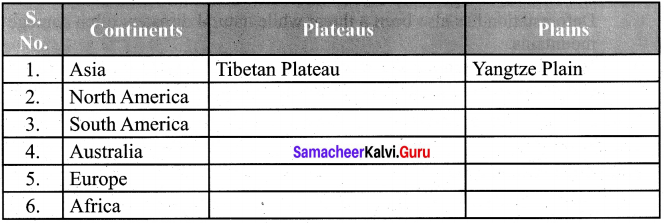
Answer:
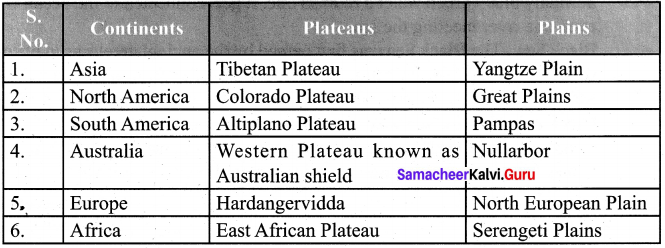
Question 3.

Answer:

Samacheer Kalvi 6th Social Science Land And Oceans Additional Questions
A. Choose the correct answer
Question 1.
The largest continent is
(a) Europe
(b) Australia
(c) North America
(d) Asia
Answer:
(d) Asia
Question 2.
Mount Everest is located in …………….
(a) India
(b) Nepal
(c) Bhutan
(d) Pakistan
Answer:
(b) Nepal
Question 3.
The longest mountain range in the world is
(a) Himalayas
(b) Rocky
(c) Andes
(d) Alps
Answer:
(c) Andes
Question 4.
Which of the following is not grouped under second-order landform?
(a) Plains
(b) Plateaus
(c) Valleys
(d) Mountains
Answer:
(c) Valleys
Question 5.
‘Roof of the world’ denotes to
(a) Tibetan Plateau
(b) Chotanagpur Plateau
(c) Deccan Plateau
(d) Malwa Plateau
Answer:
(a) Tibetan .Plaleauj
Question 6.
Bering sea is the marginal sea of the Ocean.
(a) Pacific
(b) Indian
(c) Atlantic
(d) Arctic
Answer:
(a) Pacific
Question 7.
The Reunion islands are present in Ocean.
(a) Arctic
(b) Antartic
(c) Indian
(d) Pacific
Answer:
(c) Indian
Question 8.
The land surrounded by water on three sides is called
(a) Bay
(b) Strait
(c) Peninsula
(d) Trench
Answer:
(c) Peninsula
B. Fill in the blanks :
- The highest peak in the world is ___________.
- In Sangam period, Mountain and its environs are classified as ___________ land.
- The flat topped part of the plateau is called ___________.
- The plains have been the ___________ from the earliest times.
- Plain in North India is one of the ___________largest plains in the world.
- Sand dunes form the ___________ order landforms.
- The process of removal of surface material from the Earth’s crust is called ___________.
- Chain of volcanoes present around the Pacific Ocean are called the Pacific ___________.
- The shape of the atlantic ocean resembles the letter ___________.
- .Bay of Bengal and Palk Bay are connected by ___________.
Answer:
- Mt.Aeresti
- Kurinji
- Table land
- cradle of civilisations
- Indo-Gangetif
- Third
- Erosion
- Ring of fire
- S
- Palk Strait
C. Circle the odd one out
- Rivers, Glaciers, Winds, Plains
- Mariana Trench, Tasman Sea, Philippine Sea, Strait of Gibraltar
- The Ross Sea, The Weddell Sea, The Davis Sea, The Red Sea
- Palk Strait, The Arctic Ocean, Greenland, Eurasian Basin
- Dharmapuri Plateau, Coimbatore Plateau, Madurai Plateau, Malwa Plateau
Answer:
- Plains
- Strait of Gibraltar
- The Red Sea
- Palk strait
- Malwa plateau
D. Match the following
- Kurinji – (a) Forest
- Mullai – (b) Coastal Region
- Marutham – (c) Deserts
- Neithal – (d) Agricultural land
- Palai – (e) Mountains
Answer:
- – e
- – a
- – d
- – b
- – c
E. Consider the following statements.
Question 1.
1.Andes mountains are the longest mountain range in the world.
2.Mountains come under the second order landforms.
3.The highest point of the mountain is known as peak.
Choose the correct answer using the codes given below.
(a) land 2
(b) 1,2 and 3
(c) 2 and 3
(d) 1 and 3
Answer:
(b) 1, 2 and 3
Question 2.
Consider the following statements.
Statement I : Ferdinand Magellan named the ocean Pacific, meaning calm. Statement II : Ferdinand Magellan was a Spanish navigator.
Which of the statement(s) is/are true?
(a) I is true; II is wrong
(b) I is wrong; II is true
(c) Both the statements are true
(d) Statements I and II are wrong.
Answer:
(c) Both the statements are true
F. Answer in a word
Question 1.
A broad inlet of the sea where the land curves inwards.
Answer:
Bay
Question 2.
A relatively levelled area of the earth’s surface with gentle slope.
Answer:
plain
Question 3.
The Plains of river Cauvery and Vaigai are found in the State of
Answer:
Tamil nadu
Question 4.
The eroded materials getting deposited on the low lying areas.
Answer:
Deposition
Question 5.
The Strait which connects the Atlantic ocean-to the Mediterranean Sea
Answer:
Strait of Gibraltar
G. Answer in brief.
Question 1.
Why do we see the most part of the globe in blue colour?
Answer:
We see the most part of the globe in blue colour is because of a large part of the Earth is covered by water which occupies 71 percent and land which occupies only 29 percent of the Earth’s surface.
Question 2.
Mention some of the hill stations in Tamil Nadu.
Answer:
- Udhagamandalam
- Kodaikanal
- Kolli hills
- Yercaud and Yelagiri
Question 3.
Mention some of the hill stations found in Tamil Nadu.
Answer:
Udaga mangalam, Kodaikanal, Kolli hills, Yercard and Yelagiri are some of the hill stations found in Tamil Nadu.
Question 4.
Write a short note on Third order landforms.
Answer:
- Third order landforms are formed on mountains, plateaus and plains by erosional and depositional activities of rivers, glaciers, winds and waves.
- Valleys, beaches and sand dunes are examples of third order land forms.
Question 5.
What is Oceanography ?
Answer:
The study of oceans is called Oceanography.
Question 6.
Mention the islands located in the Pacific Ocean?
Answer:
Indonesia, Philippines, Japan, Hawaii, New Zealand, are some of the islands located in the Pacific Ocean.
H. Distinguish between.
Question 1.
A continent and ocean
Answer:
Continent
- The vast land masses are called continents.
- Example: Asia, Africa, Europe.
Ocean
- Oceans are vast expanse of water.
- Example: Pacific Ocean, Atlantic Ocean.
Question 2.
An Pacific Ocean and a Atlantic Ocean Ans
Answer:
Pacific
- The largest and deepest ocean.
- It spreads out 168.72 million sq.km
- The Bering Sea, The China sea, the Sea of Japan, Tasman Sea, Philippines Sea are some of the marginal seas.
Atlantic
- Second largest ocean
- It spreads about 85.13 million sq.km
- Mediterranean Sea, The Caribbean Sea, the Gulf of Mexico, the North Sea, the Gulf of Guinea are important marginal seas.
I. Answer the following questions in detail.
Question 1.
Write a note on the Third order of landforms.
- The Third order landforms are formed on the mountains, plateaus and plains mainly by erosional and depositional activities of rivers, glaciers, winds and waves.
- Valleys, beaches and sand dimes are some examples of Third order landforms.
- Erosion is the process of removal of surface material from the Earth’s crust.
- The eroded materials are transported and deposited on the low lying areas.
- This process is called as deposition.
Question 2.
Bring out the features of the Indian Ocean.
Answer:
- The Indian ocean in the third largest ocean on the Earth’s surface.
- It covers an area of 70.56 million sq. km.
- It is triangular in shape.
- It is bounded by Africa in the west, Asia in the North and Australia in the East.
- The Andaman and Nicobar Islands, Lakshadweep, Maldives, Sri Lanka, Mauritus and the Reunion Islands are some of the islands present in the Indian Ocean.
- The Java trench is the deepest point in the Indian Ocean